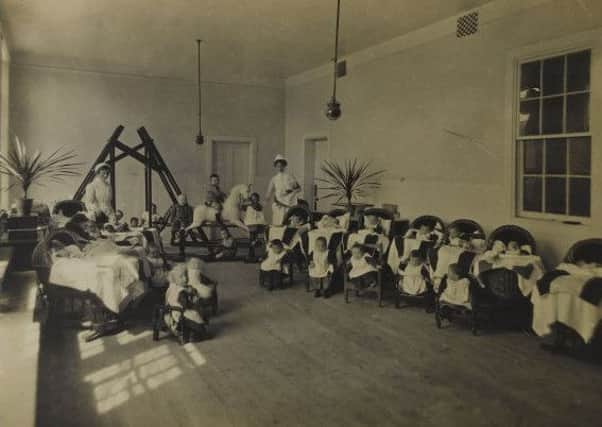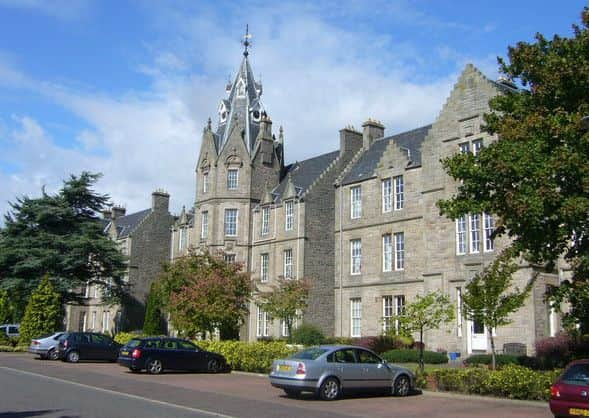Life in an Edinburgh poorhouse


There was no such thing as “dole money” to prop you up - the Unemployment Insurance Act wouldn’t be passed until 1920.
Poor families were encouraged to look to friends and relatives for assistance. An application for poor relief was the last resort.
This came in two forms: outdoor and indoor relief.


Advertisement
Hide AdAdvertisement
Hide AdOutdoor relief was a meagre welfare handout providing you with money; food; clothes or goods, but the latter option was enough to make Auld Reekie’s hoi polloi shudder with fear.
Indoor relief was ministerial speak for the poorhouse. In late 19th century Edinburgh there were two such institutions: The City Poorhouse at Craiglockhart and St Cuthbert’s at Craigleith.
Founded in 1867, The City Poorhouse was built at a cost of £35,000 and could house over 1,100 inmates. Of these, 730 were in located in the main poorhouse, 260 in the infirmary, and 160 in the lunatic asylum.


Craigleith poorhouse and hospital was founded by St Cuthbert’s parish in 1868 to replace the original St Cuthbert’s poorhouse located just west of Lothian Road. The previous building was demolished to make way for Princes Street Railway Station. Craigleith was split up into different sections for the ‘Very Decent’, ‘Decent’, ‘Bastardy’, and ‘Depraved’. The 1881 register records that the poorhouse housed 650 inmates.
Admission
Advertisement
Hide AdAdvertisement
Hide AdAdmission was relatively straightforward but not always guaranteed. Poorhouses, known as workhouses south of the border, had never been built to house the able-bodied poor, but rather they were established to aid those classified as elderly, infirm, or sick. If you couldn’t claim an illness you were expected to work for your keep.
One major benefit of the poorhouse was the fact that they offered free health care – a godsend to those who wouldn’t have been able to afford hospital treatment on the outside.
Incidents of “malingering” – where illnesses and disabilities were fabricated in order to gain automatic entry - were common, but refusal of applicants was generally discouraged for fear that people who genuinely required care might slip through the net.
Edinburgh’s cases were decided at the offices of the Edinburgh Parish Council on Castle Terrace. Parish councillors required basic details such as name, age, place of birth, and the person’s trade or area of expertise. The claimant’s physical condition was also discussed at great length.
Advertisement
Hide AdAdvertisement
Hide AdShould the application be approved, the cost of settlement was met by the person’s local parish.
Arrival
New inmates were taken by carriage to their destination and soon stripped of all clothing and personal belongings. A series of medical examinations were undertaken to determine the inmate’s physical and mental state.
Once bathed all inmates were expected to wear the distinctive garb which the institution provided. The clothes the inmate was wearing upon arrival were sent to be steamed and fumigated and only returned at the point of discharge.
Work
Work was allocated according to the physical health, ability and disposition of the inmate in question.
Advertisement
Hide AdAdvertisement
Hide AdCommon occupations for men at Craiglockhart and Craigleith included stone-breaking; floor-scrubbing; and stick bunching. The latter was a lucrative trade involving the bundling and distribution of firewood.
Inmates on firewood delivery duty would be expected to travel into town by horse and cart dressed in full institutional uniform – a humiliating experience if they happened to bump into someone they knew.
Those who happened to possess a specific skill such as painters, joiners, and shoemakers were often put to their own trade.
Women were expected to perform domestic tasks in the poorhouse such as cooking, cleaning and doing laundry. Knitting and sewing were also common.
Advertisement
Hide AdAdvertisement
Hide AdOakum teasing or rope-making duties were generally reserved for less able or elderly inmates.
Diet
Meal and milk, more commonly known as gruel, was served two to three times every day, with broth served at lunch. One inmate at Craigleith in 1906 described the fare as “inadequate” and “nauseating”.
Inmates had just 20 minutes at lunchtime to collect their food, take a seat and finish their meal before being sent to graft again. Any leftovers would be disposed of.
Anyone caught taking food from the dining hall faced severe punishment, which often involved dietary restrictions or confinement for up to 48 hours. Similar penalties could be enforced for other “minor” offences too, such as swearing.
Advertisement
Hide AdAdvertisement
Hide AdAlcohol consumption was strictly forbidden and could result in jail time.
Segregation
Segregation of inmates, based on gender was rigidly enforced. Even married couples at Craiglockhart and Craigleith barely saw one another save during a heavily-supervised half hour once every Saturday. Children, also subject to gender segregation, were present at both poorhouses, but those without families were generally kept on a temporary basis before being fostered out to orphanages and boarding schools.
The original plans for Craiglockhart’s City Poorhouse reveal a series of family cottages with gardens were to be built opposite the main complex. However this idea was scrapped at the last minute by the Local Government Board who felt that it contravened the Poor Law.
Abolishment of the Poor Law Act
The Poor Law Act was finally abolished in 1948 having been in operation for over a century.
Advertisement
Hide AdAdvertisement
Hide AdAt the end of WWII Craiglockhart was transformed into a home for the elderly and was later renamed Greenlea Old People’s Home. The original buildings were preserved and converted into residential housing in the late 1980s.
Craigleith Poorhouse was used for the treatment of injured soldiers during WWI. Later on it was redeveloped to become Craigleith Hospital, before being renamed as the Western General Hospital in 1929.
Approximately one in every ten Scots have ancestors who spent time living in poorhouses between the 1840s and 1930s.
DOWNLOAD THE EDINBURGH EVENING NEWS APP ON ITUNES OR GOOGLE PLAY
